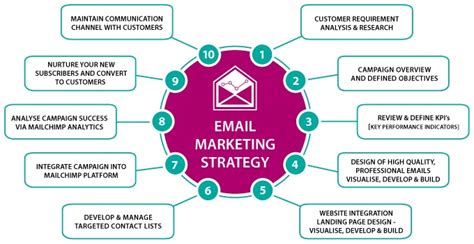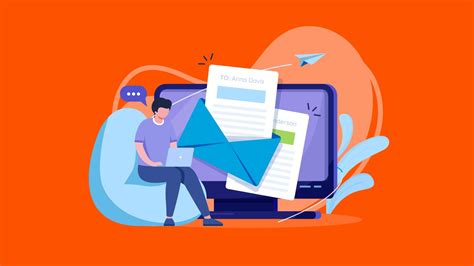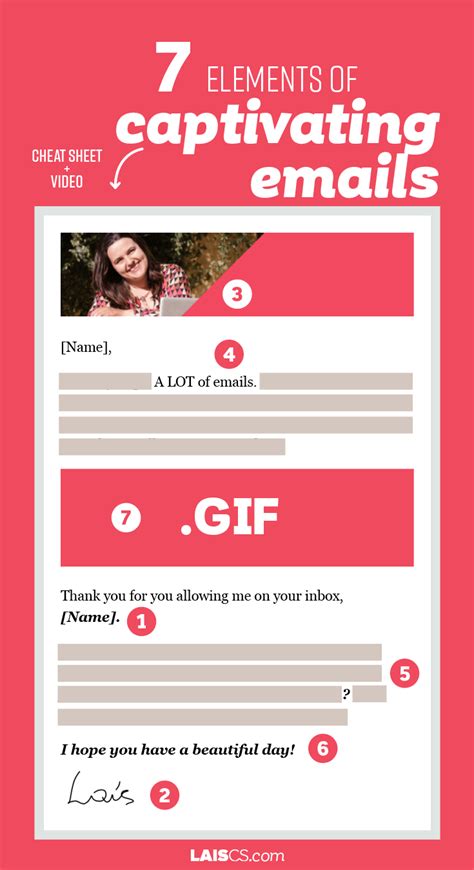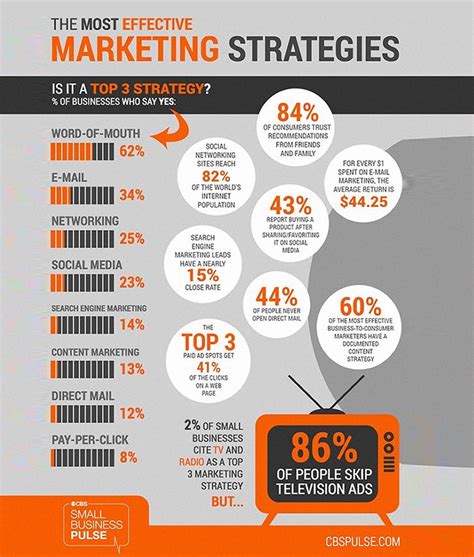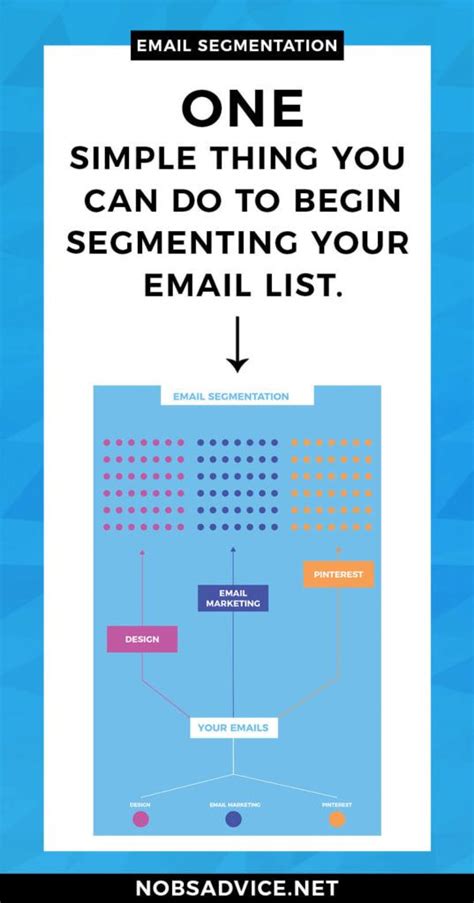When it comes to reaching out to your target audience effectively and leaving a lasting impression, email promotion remains an invaluable tool. Crafting engaging and persuasive emails, however, requires finesse and a deep understanding of your audience's preferences. In this article, we will explore ten practical and proven tips to elevate the impact of your email marketing campaigns.
1. Personalize your Messages: Gone are the days of generic email blasts. Tailoring your emails to address each recipient personally brings a touch of authenticity and enhances the likelihood of engagement. Delve into subscriber data to gain insights into their preferences, demographics, and past interactions, allowing you to deliver targeted and customized content that resonates.
2. Captivating Subject Lines: First impressions matter, and your subject line is your gateway to capturing your reader's attention. Craft compelling subject lines that arouse curiosity, evoke emotions, or provide enticing offers, ensuring that your emails stand out in crowded inboxes and compelling recipients to open.
3. Engaging Content: The heart of an effective email lies in its content. Deliver value by offering informative, entertaining, and useful content tailored to your audience's needs. The key is to strike a balance between promotional messages and providing valuable information that keeps your subscribers engaged and eagerly anticipating your next email.
4. Mobile Optimization: In today's mobile-centric world, optimizing your emails for mobile devices is no longer optional; it is essential. With a significant portion of emails being accessed on smartphones, ensure that your emails are mobile-friendly, with easily digestible content, responsive design, and well-placed call-to-action buttons.
5. Segment your Audience: Treating your entire subscriber base as a homogenous group may result in missed opportunities. Segment your audience based on factors such as demographics, purchasing behavior, or engagement levels to deliver targeted messages that speak directly to their needs and interests.
6. Automated Workflows: Streamline your email marketing efforts by utilizing automated workflows. Whether it's sending welcome emails to new subscribers, nurturing leads, or recovering abandoned carts, automated workflows save time and ensure timely and relevant communication with your audience.
7. Clear Call-to-Actions: Guide your subscribers towards desired actions by incorporating clear and compelling call-to-action buttons. Make them stand out visually, use actionable language, and provide a direct benefit or incentive to encourage click-through rates and drive conversions.
8. A/B Testing: Experimentation is the key to continual improvement. Conduct A/B tests with different elements of your emails, such as subject lines, layouts, or content, to determine what resonates best with your audience. Analyze the results and refine your approach based on data-driven insights.
9. Regular Analysis and Optimization: Success in email marketing requires a commitment to continuous learning and improvement. Regularly analyze performance metrics such as open rates, click-through rates, and conversion rates. Based on the data, optimize your email strategy, content, and design to ensure optimal results.
10. Maintain Consistency and Frequency: Building a strong relationship with your subscribers necessitates consistent and regular communication. Set a content calendar and adhere to a frequency that strikes a balance between staying top-of-mind and avoiding overwhelming your subscribers. Consistency builds trust and helps establish your brand as a reliable source of valuable information.
By implementing these ten strategies, you can elevate your email marketing game and achieve greater engagement, conversions, and success. Remember, email marketing is an evolving field, so always stay up-to-date with the latest best practices and be adaptable to ever-changing consumer preferences.
Enhance Your Email Campaign Performance with These 10 Proven Strategies
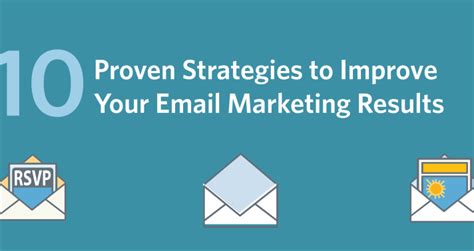
Looking to take your email marketing efforts to the next level? Gain an advantage by implementing these expert techniques that can significantly improve the results achieved through your email campaigns. Harness the power of these advanced strategies to elevate your email marketing game and maximize your potential for success.
Crafting Engaging Subject Lines: Boosting Open Rates
Creating compelling subject lines is a crucial element in increasing the open rates of your email campaigns. A well-crafted subject line has the power to captivate and entice your subscribers, encouraging them to open and engage with your emails.
When it comes to crafting captivating subject lines, communication is key. It is important to convey a sense of urgency or exclusivity, sparking curiosity and compelling your subscribers to take action. Using power words and emotional triggers can help elicit a response from your audience, encouraging them to open your emails and explore further.
| 1. Personalization | Incorporate personalized elements, such as the recipient's name or location, to create a sense of individuality. |
| 2. Intrigue | Pique curiosity by teasing intriguing content or offering an exclusive sneak peek. |
| 3. Urgency | Create a sense of urgency by highlighting limited-time offers or time-sensitive information. |
| 4. Relevance | Ensure your subject line aligns with your email content, delivering on the promises made. |
| 5. Simplicity | Keep your subject lines concise and to the point, avoiding excessive length or complexity. |
| 6. Creativity | Infuse creativity and humor into your subject lines to stand out in crowded inboxes. |
| 7. Emotion | Evoke emotions by using powerful and relevant words that resonate with your audience. |
| 8. Personal Touch | Make your subscribers feel special by addressing their pain points or offering tailored solutions. |
| 9. A/B Testing | Experiment with different subject lines to identify what resonates best with your audience. |
| 10. Mobile Optimization | Optimize your subject lines for mobile devices to ensure maximum visibility on various screens. |
By implementing these strategies and continuously refining your subject line approach, you can boost open rates, increase engagement, and ultimately drive better results for your email marketing campaigns.
Enhance Email Effectiveness through Personalization
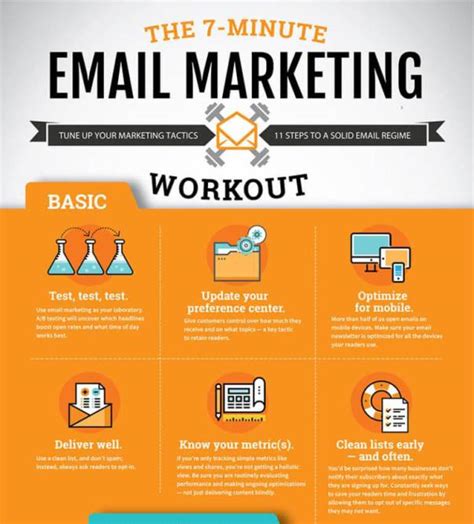
Connect with your audience on a deeper level by incorporating personalized elements into your email marketing strategy. By tailoring your emails to resonate with each individual recipient, you can create a more engaging and impactful experience.
| 1. Customize Subject Lines: | Grab attention with subject lines that speak directly to the recipient's interests or needs. |
| 2. Segment Your Email List: | Divide your subscribers into smaller groups based on demographics, preferences, or past interactions. This allows you to send targeted messages that cater to specific interests. |
| 3. Utilize Dynamic Content: | Inject dynamic content into your emails, such as personalized greetings, product recommendations, or location-specific offers. This creates a sense of relevancy and exclusivity. |
| 4. Leverage Customer Data: | Tap into the information you have about your subscribers to craft personalized emails. This can include their purchase history, browsing behavior, or engagement with previous campaigns. |
| 5. Create Personalized Call-to-Actions: | Encourage desired actions by tailoring your CTAs to each recipient. Use language that resonates with their interests or motivates them based on their specific needs. |
| 6. Use First-Name Basis: | Address your subscribers by their first name – a simple yet highly effective way to create a personalized touch and strengthen the relationship with your audience. |
| 7. Reference Recent Interactions: | Incorporate references to recent interactions or purchases made by the recipient. This adds a personal touch and shows that you value their engagement with your brand. |
| 8. Send Relevant Content: | Ensure that the content you include in your emails aligns with each recipient's interests. Tailor the information to provide value and relevance to their specific needs. |
| 9. Implement User-Generated Content: | Showcase testimonials, reviews, or social media posts from happy customers. This not only adds credibility to your brand but also creates a sense of community and personal connection. |
| 10. Continuously Analyze and Improve: | Regularly evaluate the performance of your personalized email campaigns. Analyze open rates, click-through rates, and conversion metrics to fine-tune your approach and optimize results. |
By personalizing your emails, you can cultivate a stronger bond with your subscribers, increase engagement, and ultimately drive better results for your email marketing campaigns. So, start incorporating these strategies and witness the positive impact of personalized communication.
Segmenting Your Email List for Tailored Content Delivery
In order to maximize the effectiveness of your email marketing campaigns, it is crucial to segment your email list and deliver tailored content to different groups of subscribers. By dividing your subscribers into specific segments based on demographics, interests, purchase history, or behavior, you can ensure that each recipient receives relevant and personalized content that resonates with their individual needs and preferences.
| Benefits of Segmentation |
|---|
1. Personalization: Segmenting your email list allows you to craft messages that directly speak to the interests and desires of each subscriber, making them more likely to engage with your content and take action. 2. Increased Engagement: When subscribers receive content that is specifically tailored to their needs, they are more likely to open and click on your emails, leading to higher engagement rates and ultimately, increased conversions. 3. Improved Deliverability: By sending targeted emails to smaller, more engaged segments, you can reduce the risk of triggering spam filters and improve the overall deliverability rates of your campaigns. 4. Better ROI: When your emails resonate with the recipients, it not only improves their perception of your brand but also increases the likelihood of them making a purchase or taking a desired action, resulting in a higher return on investment (ROI). |
Segmenting your email list can be done through various means. You can collect data from sign-up forms, preference centers, or customer surveys to gather information about your subscribers' demographics, interests, and preferences. Additionally, you can track user behavior on your website or within your emails to identify patterns and create segments based on their actions.
Once your segments are defined, it is important to tailor the content of your emails accordingly. This can include personalizing the subject lines, email copy, and calls-to-action to align with the specific needs and interests of each segment. By doing so, you can increase the chances of your emails resonating with your subscribers and driving the desired actions.
Segmenting your email list and delivering targeted content is a powerful strategy that can significantly boost the effectiveness of your email marketing campaigns. By understanding your subscribers' preferences and delivering relevant content, you can create stronger connections, foster engagement, and drive better results for your business.
FAQ
How can I improve my email marketing success?
There are 10 tips that can help boost your email marketing success. These tips include creating compelling subject lines, personalizing your emails, segmenting your audience, optimizing for mobile devices, utilizing automation, testing and refining your campaigns, providing valuable content, keeping your emails concise, including clear call-to-actions, and analyzing your email marketing metrics. By following these tips, you can effectively enhance your email marketing success.
Why is it important to have compelling subject lines in email marketing?
Having compelling subject lines is crucial in email marketing because they are the first thing that recipients see in their inbox. A captivating subject line can grab the attention of your audience, encourage them to open your email, and increase your email open rates. It is important to make your subject lines concise, intriguing, and personalized to effectively engage your subscribers.
What is the significance of segmenting your email audience?
Segmenting your email audience is vital for email marketing success as it allows you to deliver targeted and relevant content to specific groups of subscribers. By dividing your audience based on demographics, interests, purchase behavior, or engagement levels, you can tailor your email campaigns to cater to their specific needs and preferences. This results in higher engagement, improved click-through rates, and increased conversions.
How can automation improve email marketing?
Automation plays a crucial role in email marketing by streamlining and simplifying various tasks. It allows you to set up automated email sequences, such as welcome emails, abandoned cart reminders, or birthday greetings, based on predefined triggers or actions. Automation saves time, ensures timely and relevant communication with your subscribers, and helps nurture leads throughout the customer journey, ultimately boosting your email marketing success.
